Example 19 - Faulted Folded Layers
Contents
Example 19 - Faulted Folded Layers#
This example will show how to convert the geological map below using GemGIS to a GemPy model. This example is based on digitized data. The area is 3990 m wide (W-E extent) and 2736 m high (N-S extent). The vertical model extent varies from 0 m to 1000 m. The model represents folded layers with a NW-SE striking fault running through the area and a Limestone unit unconformably overlaying the coal measures.
The map has been georeferenced with QGIS. The stratigraphic boundaries were digitized in QGIS. Strikes lines were digitized in QGIS as well and will be used to calculate orientations for the GemPy model. The contour lines were also digitized and will be interpolated with GemGIS to create a topography for the model.
Map Source: An Introduction to Geological Structures and Maps by G.M. Bennison
[1]:
import matplotlib.pyplot as plt
import matplotlib.image as mpimg
img = mpimg.imread('../images/cover_example19.png')
plt.figure(figsize=(10, 10))
imgplot = plt.imshow(img)
plt.axis('off')
plt.tight_layout()
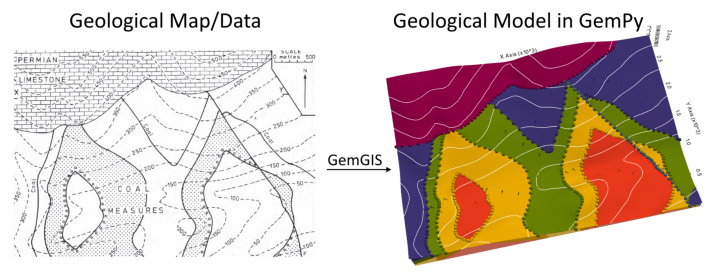
Licensing#
Computational Geosciences and Reservoir Engineering, RWTH Aachen University, Authors: Alexander Juestel. For more information contact: alexander.juestel(at)rwth-aachen.de
This work is licensed under a Creative Commons Attribution 4.0 International License (http://creativecommons.org/licenses/by/4.0/)
Import GemGIS#
If you have installed GemGIS via pip or conda, you can import GemGIS like any other package. If you have downloaded the repository, append the path to the directory where the GemGIS repository is stored and then import GemGIS.
[2]:
import warnings
warnings.filterwarnings("ignore")
import gemgis as gg
Importing Libraries and loading Data#
All remaining packages can be loaded in order to prepare the data and to construct the model. The example data is downloaded from an external server using pooch. It will be stored in a data folder in the same directory where this notebook is stored.
[3]:
import geopandas as gpd
import rasterio
[4]:
file_path = 'data/example19/'
gg.download_gemgis_data.download_tutorial_data(filename="example19_faulted_folded_layers.zip", dirpath=file_path)
Downloading file 'example19_faulted_folded_layers.zip' from 'https://rwth-aachen.sciebo.de/s/AfXRsZywYDbUF34/download?path=%2Fexample19_faulted_folded_layers.zip' to 'C:\Users\ale93371\Documents\gemgis\docs\getting_started\example\data\example19'.
Creating Digital Elevation Model from Contour Lines#
The digital elevation model (DEM) will be created by interpolating contour lines digitized from the georeferenced map using the SciPy Radial Basis Function interpolation wrapped in GemGIS. The respective function used for that is gg.vector.interpolate_raster().
[5]:
import matplotlib.pyplot as plt
import matplotlib.image as mpimg
img = mpimg.imread('../images/dem_example19.png')
plt.figure(figsize=(10, 10))
imgplot = plt.imshow(img)
plt.axis('off')
plt.tight_layout()
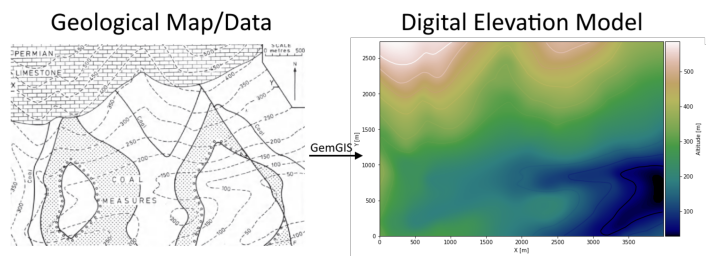
[6]:
topo = gpd.read_file(file_path + 'topo19.shp')
topo.head()
[6]:
| id | Z | geometry | |
|---|---|---|---|
| 0 | None | 300 | LINESTRING (8.174 150.549, 50.466 70.194, 80.9... |
| 1 | None | 300 | LINESTRING (3.099 239.363, 31.011 304.493, 55.... |
| 2 | None | 550 | LINESTRING (3.944 2537.526, 66.114 2492.273, 1... |
| 3 | None | 500 | LINESTRING (3.099 2351.862, 90.221 2275.736, 1... |
| 4 | None | 450 | LINESTRING (3.099 2193.266, 109.252 2093.034, ... |
Interpolating the contour lines#
[7]:
topo_raster = gg.vector.interpolate_raster(gdf=topo, value='Z', method='rbf', res=10)
Plotting the raster#
[8]:
import matplotlib.pyplot as plt
from mpl_toolkits.axes_grid1 import make_axes_locatable
fix, ax = plt.subplots(1, figsize=(10, 10))
topo.plot(ax=ax, aspect='equal', column='Z', cmap='gist_earth')
im = ax.imshow(topo_raster, origin='lower', extent=[0, 3990, 0, 2736], cmap='gist_earth')
divider = make_axes_locatable(ax)
cax = divider.append_axes("right", size="5%", pad=0.05)
cbar = plt.colorbar(im, cax=cax)
cbar.set_label('Altitude [m]')
ax.set_xlabel('X [m]')
ax.set_ylabel('Y [m]')
ax.set_xlim(0, 3990)
ax.set_ylim(0, 2736)
[8]:
(0.0, 2736.0)
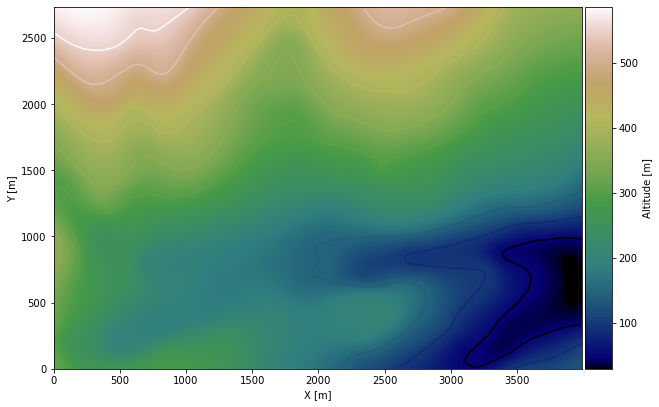
Saving the raster to disc#
After the interpolation of the contour lines, the raster is saved to disc using gg.raster.save_as_tiff(). The function will not be executed as a raster is already provided with the example data.
Opening Raster#
The previously computed and saved raster can now be opened using rasterio.
[9]:
topo_raster = rasterio.open(file_path + 'raster19.tif')
Interface Points of stratigraphic boundaries#
The interface points will be extracted from LineStrings digitized from the georeferenced map using QGIS. It is important to provide a formation name for each layer boundary. The vertical position of the interface point will be extracted from the digital elevation model using the GemGIS function gg.vector.extract_xyz(). The resulting GeoDataFrame now contains single points including the information about the respective formation.
[10]:
import matplotlib.pyplot as plt
import matplotlib.image as mpimg
img = mpimg.imread('../images/interfaces_example19.png')
plt.figure(figsize=(10, 10))
imgplot = plt.imshow(img)
plt.axis('off')
plt.tight_layout()
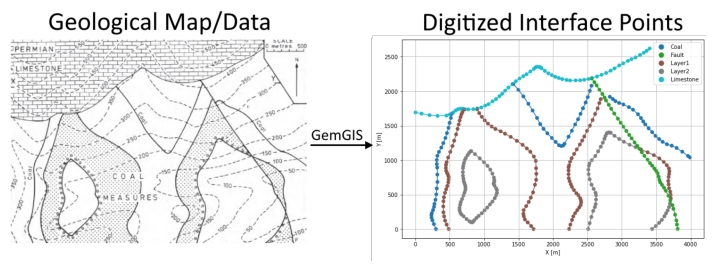
[11]:
interfaces = gpd.read_file(file_path + 'interfaces19.shp')
interfaces.head()
[11]:
| id | formation | geometry | |
|---|---|---|---|
| 0 | None | Fault | LINESTRING (3811.835 3.901, 3800.205 67.868, 3... |
| 1 | None | Coal | LINESTRING (299.990 2.579, 269.064 74.740, 248... |
| 2 | None | Coal | LINESTRING (1422.850 2103.184, 1497.390 2019.1... |
| 3 | None | Coal | LINESTRING (2825.632 1919.212, 2868.453 1886.7... |
| 4 | None | Limestone | LINESTRING (2.623 1692.420, 90.644 1675.767, 2... |
Extracting Z coordinate from Digital Elevation Model#
[12]:
interfaces_coords = gg.vector.extract_xyz(gdf=interfaces, dem=topo_raster)
interfaces_coords = interfaces_coords.sort_values(by='formation', ascending=False)
interfaces_coords = interfaces_coords[interfaces_coords['formation'].isin(['Limestone', 'Fault', 'Layer2', 'Layer1', 'Coal'])]
interfaces_coords.head()
[12]:
| formation | geometry | X | Y | Z | |
|---|---|---|---|---|---|
| 161 | Limestone | POINT (2453.526 2165.433) | 2453.53 | 2165.43 | 411.30 |
| 171 | Limestone | POINT (3088.307 2439.011) | 3088.31 | 2439.01 | 416.81 |
| 165 | Limestone | POINT (2706.091 2237.990) | 2706.09 | 2237.99 | 420.49 |
| 166 | Limestone | POINT (2771.908 2263.366) | 2771.91 | 2263.37 | 418.46 |
| 167 | Limestone | POINT (2836.932 2297.464) | 2836.93 | 2297.46 | 419.85 |
Plotting the Interface Points#
[13]:
fig, ax = plt.subplots(1, figsize=(10, 10))
interfaces.plot(ax=ax, column='formation', legend=True, aspect='equal')
interfaces_coords.plot(ax=ax, column='formation', legend=True, aspect='equal')
plt.grid()
ax.set_xlabel('X [m]')
ax.set_ylabel('Y [m]')
ax.set_xlim(0, 3990)
ax.set_ylim(0, 2736)
[13]:
(0.0, 2736.0)
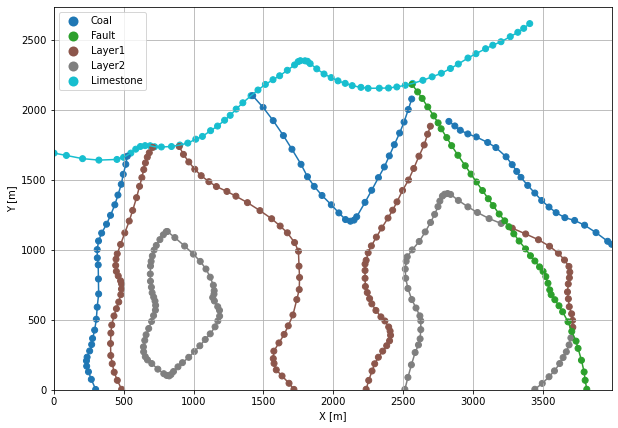
Orientations from Strike Lines#
Strike lines connect outcropping stratigraphic boundaries (interfaces) of the same altitude. In other words: the intersections between topographic contours and stratigraphic boundaries at the surface. The height difference and the horizontal difference between two digitized lines is used to calculate the dip and azimuth and hence an orientation that is necessary for GemPy. In order to calculate the orientations, each set of strikes lines/LineStrings for one formation must be given an id
number next to the altitude of the strike line. The id field is already predefined in QGIS. The strike line with the lowest altitude gets the id number 1, the strike line with the highest altitude the the number according to the number of digitized strike lines. It is currently recommended to use one set of strike lines for each structural element of one formation as illustrated.
[14]:
import matplotlib.pyplot as plt
import matplotlib.image as mpimg
img = mpimg.imread('../images/orientations_example19.png')
plt.figure(figsize=(10, 10))
imgplot = plt.imshow(img)
plt.axis('off')
plt.tight_layout()
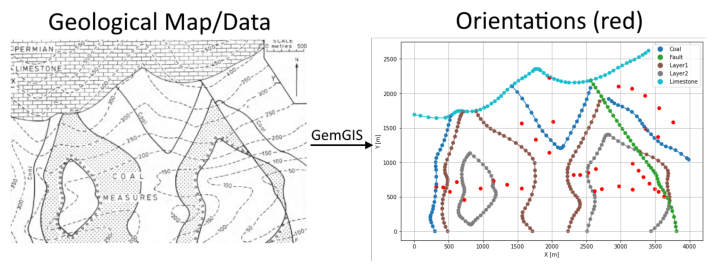
[15]:
strikes = gpd.read_file(file_path + 'strikes19.shp')
strikes.head()
[15]:
| id | formation | Z | geometry | |
|---|---|---|---|---|
| 0 | 1 | Fault | 50 | LINESTRING (3757.979 278.933, 3593.039 618.328) |
| 1 | 2 | Fault | 100 | LINESTRING (3800.800 93.375, 3345.629 1038.608) |
| 2 | 3 | Fault | 150 | LINESTRING (3248.886 1171.829, 3803.972 1.390) |
| 3 | 4 | Fault | 200 | LINESTRING (3147.384 1309.807, 3770.667 -6.540) |
| 4 | 5 | Fault | 250 | LINESTRING (3010.991 1501.708, 3731.017 -9.712) |
Calculate Orientations for each formation#
[16]:
orientations_limestone = gg.vector.calculate_orientations_from_strike_lines(gdf=strikes[strikes['formation'] == 'Limestone'].sort_values(by='Z', ascending=True).reset_index())
orientations_limestone
[16]:
| dip | azimuth | Z | geometry | polarity | formation | X | Y | |
|---|---|---|---|---|---|---|---|---|
| 0 | 8.97 | 339.97 | 375.00 | POINT (1957.914 2225.303) | 1.00 | Limestone | 1957.91 | 2225.30 |
[17]:
orientations_fault = gg.vector.calculate_orientations_from_strike_lines(gdf=strikes[strikes['formation'] == 'Fault'].sort_values(by='Z', ascending=True).reset_index())
orientations_fault
[17]:
| dip | azimuth | Z | geometry | polarity | formation | X | Y | |
|---|---|---|---|---|---|---|---|---|
| 0 | 50.95 | 64.26 | 75.00 | POINT (3624.362 507.311) | 1.00 | Fault | 3624.36 | 507.31 |
| 1 | 58.76 | 64.49 | 125.00 | POINT (3549.822 576.300) | 1.00 | Fault | 3549.82 | 576.30 |
| 2 | 56.82 | 64.65 | 175.00 | POINT (3492.727 619.121) | 1.00 | Fault | 3492.73 | 619.12 |
| 3 | 53.36 | 64.59 | 225.00 | POINT (3415.015 698.816) | 1.00 | Fault | 3415.01 | 698.82 |
| 4 | 55.58 | 64.56 | 275.00 | POINT (3329.373 792.784) | 1.00 | Fault | 3329.37 | 792.78 |
| 5 | 65.78 | 64.73 | 325.00 | POINT (3253.247 881.201) | 1.00 | Fault | 3253.25 | 881.20 |
| 6 | 59.48 | 64.76 | 375.00 | POINT (3172.363 982.703) | 1.00 | Fault | 3172.36 | 982.70 |
[18]:
orientations_layer2 = gg.vector.calculate_orientations_from_strike_lines(gdf=strikes[strikes['formation'] == 'Layer2'].sort_values(by='Z', ascending=True).reset_index())
orientations_layer2
[18]:
| dip | azimuth | Z | geometry | polarity | formation | X | Y | |
|---|---|---|---|---|---|---|---|---|
| 0 | 28.13 | 269.43 | 175.00 | POINT (2619.061 582.446) | 1.00 | Layer2 | 2619.06 | 582.45 |
| 1 | 24.29 | 269.17 | 225.00 | POINT (2722.941 617.734) | 1.00 | Layer2 | 2722.94 | 617.73 |
[19]:
orientations_layer2a = gg.vector.calculate_orientations_from_strike_lines(gdf=strikes[strikes['formation'] == 'Layer2a'].sort_values(by='Z', ascending=True).reset_index())
orientations_layer2a
[19]:
| dip | azimuth | Z | geometry | polarity | formation | X | Y | |
|---|---|---|---|---|---|---|---|---|
| 0 | 13.90 | 88.28 | 175.00 | POINT (3168.002 606.434) | 1.00 | Layer2a | 3168.00 | 606.43 |
| 1 | 15.16 | 88.43 | 225.00 | POINT (2971.541 659.960) | 1.00 | Layer2a | 2971.54 | 659.96 |
[20]:
orientations_layer2b = gg.vector.calculate_orientations_from_strike_lines(gdf=strikes[strikes['formation'] == 'Layer2b'].sort_values(by='Z', ascending=True).reset_index())
orientations_layer2b
[20]:
| dip | azimuth | Z | geometry | polarity | formation | X | Y | |
|---|---|---|---|---|---|---|---|---|
| 0 | 14.01 | 89.59 | 225.00 | POINT (963.913 621.104) | 1.00 | Layer2b | 963.91 | 621.10 |
[21]:
orientations_layer2c = gg.vector.calculate_orientations_from_strike_lines(gdf=strikes[strikes['formation'] == 'Layer2c'].sort_values(by='Z', ascending=True).reset_index())
orientations_layer2c
[21]:
| dip | azimuth | Z | geometry | polarity | formation | X | Y | |
|---|---|---|---|---|---|---|---|---|
| 0 | 24.58 | 269.89 | 225.00 | POINT (722.451 459.732) | 1.00 | Layer2c | 722.45 | 459.73 |
[22]:
orientations_layer1a = gg.vector.calculate_orientations_from_strike_lines(gdf=strikes[strikes['formation'] == 'Layer1a'].sort_values(by='Z', ascending=True).reset_index())
orientations_layer1a
[22]:
| dip | azimuth | Z | geometry | polarity | formation | X | Y | |
|---|---|---|---|---|---|---|---|---|
| 0 | 29.74 | 269.93 | 175.00 | POINT (2311.583 820.142) | 1.00 | Layer1a | 2311.58 | 820.14 |
| 1 | 25.64 | 269.79 | 225.00 | POINT (2410.309 818.159) | 1.00 | Layer1a | 2410.31 | 818.16 |
| 2 | 21.62 | 269.51 | 275.00 | POINT (2527.670 849.086) | 1.00 | Layer1a | 2527.67 | 849.09 |
| 3 | 28.17 | 269.31 | 325.00 | POINT (2639.084 904.594) | 1.00 | Layer1a | 2639.08 | 904.59 |
[23]:
orientations_layer1b = gg.vector.calculate_orientations_from_strike_lines(gdf=strikes[strikes['formation'] == 'Layer1b'].sort_values(by='Z', ascending=True).reset_index())
orientations_layer1b
[23]:
| dip | azimuth | Z | geometry | polarity | formation | X | Y | |
|---|---|---|---|---|---|---|---|---|
| 0 | 13.52 | 89.97 | 225.00 | POINT (1561.027 623.284) | 1.00 | Layer1b | 1561.03 | 623.28 |
| 1 | 13.31 | 90.14 | 275.00 | POINT (1349.698 678.991) | 1.00 | Layer1b | 1349.70 | 678.99 |
| 2 | 15.20 | 90.57 | 325.00 | POINT (1147.488 736.879) | 1.00 | Layer1b | 1147.49 | 736.88 |
[24]:
orientations_layer1c = gg.vector.calculate_orientations_from_strike_lines(gdf=strikes[strikes['formation'] == 'Layer1c'].sort_values(by='Z', ascending=True).reset_index())
orientations_layer1c
[24]:
| dip | azimuth | Z | geometry | polarity | formation | X | Y | |
|---|---|---|---|---|---|---|---|---|
| 0 | 26.25 | 269.71 | 275.00 | POINT (514.888 575.111) | 1.00 | Layer1c | 514.89 | 575.11 |
| 1 | 28.43 | 269.71 | 325.00 | POINT (612.623 721.416) | 1.00 | Layer1c | 612.62 | 721.42 |
[25]:
orientations_layer1d = gg.vector.calculate_orientations_from_strike_lines(gdf=strikes[strikes['formation'] == 'Layer1d'].sort_values(by='Z', ascending=True).reset_index())
orientations_layer1d
[25]:
| dip | azimuth | Z | geometry | polarity | formation | X | Y | |
|---|---|---|---|---|---|---|---|---|
| 0 | 17.60 | 89.66 | 75.00 | POINT (3539.315 1371.263) | 1.00 | Layer1d | 3539.31 | 1371.26 |
| 1 | 13.66 | 89.75 | 125.00 | POINT (3356.334 1492.986) | 1.00 | Layer1d | 3356.33 | 1492.99 |
[26]:
orientations_coal = gg.vector.calculate_orientations_from_strike_lines(gdf=strikes[strikes['formation'] == 'Coal'].sort_values(by='Z', ascending=True).reset_index())
orientations_coal
[26]:
| dip | azimuth | Z | geometry | polarity | formation | X | Y | |
|---|---|---|---|---|---|---|---|---|
| 0 | 14.02 | 89.91 | 225.00 | POINT (1955.842 1142.621) | 1.00 | Coal | 1955.84 | 1142.62 |
| 1 | 14.99 | 89.72 | 275.00 | POINT (1761.056 1331.614) | 1.00 | Coal | 1761.06 | 1331.61 |
| 2 | 13.15 | 89.66 | 325.00 | POINT (1558.846 1571.094) | 1.00 | Coal | 1558.85 | 1571.09 |
| 3 | 2.56 | 269.64 | 375.00 | POINT (2010.954 1589.465) | 1.00 | Coal | 2010.95 | 1589.47 |
[27]:
orientations_coal1 = gg.vector.calculate_orientations_from_strike_lines(gdf=strikes[strikes['formation'] == 'Coal1'].sort_values(by='Z', ascending=True).reset_index())
orientations_coal1
[27]:
| dip | azimuth | Z | geometry | polarity | formation | X | Y | |
|---|---|---|---|---|---|---|---|---|
| 0 | 24.80 | 270.11 | 275.00 | POINT (316.048 650.841) | 1.00 | Coal1 | 316.05 | 650.84 |
| 1 | 28.64 | 269.67 | 325.00 | POINT (421.118 644.100) | 1.00 | Coal1 | 421.12 | 644.10 |
[28]:
orientations_coal2 = gg.vector.calculate_orientations_from_strike_lines(gdf=strikes[strikes['formation'] == 'Coal1'].sort_values(by='Z', ascending=True).reset_index())
orientations_coal2
[28]:
| dip | azimuth | Z | geometry | polarity | formation | X | Y | |
|---|---|---|---|---|---|---|---|---|
| 0 | 24.80 | 270.11 | 275.00 | POINT (316.048 650.841) | 1.00 | Coal1 | 316.05 | 650.84 |
| 1 | 28.64 | 269.67 | 325.00 | POINT (421.118 644.100) | 1.00 | Coal1 | 421.12 | 644.10 |
[29]:
orientations_coal3 = gg.vector.calculate_orientations_from_strike_lines(gdf=strikes[strikes['formation'] == 'Coal3'].sort_values(by='Z', ascending=True).reset_index())
orientations_coal3
[29]:
| dip | azimuth | Z | geometry | polarity | formation | X | Y | |
|---|---|---|---|---|---|---|---|---|
| 0 | 13.05 | 89.95 | 125.00 | POINT (3760.576 1586.625) | 1.00 | Coal3 | 3760.58 | 1586.62 |
| 1 | 14.01 | 90.25 | 175.00 | POINT (3551.229 1787.645) | 1.00 | Coal3 | 3551.23 | 1787.65 |
| 2 | 14.47 | 90.32 | 225.00 | POINT (3352.588 1968.841) | 1.00 | Coal3 | 3352.59 | 1968.84 |
| 3 | 27.49 | 90.07 | 300.00 | POINT (3158.704 2070.343) | 1.00 | Coal3 | 3158.70 | 2070.34 |
| 4 | 14.49 | 89.80 | 375.00 | POINT (2964.424 2098.493) | 1.00 | Coal3 | 2964.42 | 2098.49 |
Merging Orientations#
[30]:
import pandas as pd
orientations = pd.concat([orientations_limestone, orientations_fault, orientations_layer2, orientations_layer2a, orientations_layer2b, orientations_layer2c, orientations_layer1a, orientations_layer1b, orientations_layer1c, orientations_layer1d, orientations_coal, orientations_coal1, orientations_coal2, orientations_coal3]).reset_index()
orientations['formation'] = ['Limestone', 'Fault', 'Fault', 'Fault', 'Fault', 'Fault', 'Fault', 'Fault', 'Layer2', 'Layer2', 'Layer2', 'Layer2', 'Layer2', 'Layer2', 'Layer1', 'Layer1', 'Layer1', 'Layer1', 'Layer1', 'Layer1', 'Layer1', 'Layer1', 'Layer1', 'Layer1', 'Layer1', 'Coal', 'Coal', 'Coal', 'Coal', 'Coal', 'Coal', 'Coal', 'Coal', 'Coal', 'Coal', 'Coal', 'Coal', 'Coal']
orientations = orientations[orientations['formation'].isin(['Limestone', 'Fault', 'Layer2', 'Layer1', 'Coal'])]
orientations
[30]:
| index | dip | azimuth | Z | geometry | polarity | formation | X | Y | |
|---|---|---|---|---|---|---|---|---|---|
| 0 | 0 | 8.97 | 339.97 | 375.00 | POINT (1957.914 2225.303) | 1.00 | Limestone | 1957.91 | 2225.30 |
| 1 | 0 | 50.95 | 64.26 | 75.00 | POINT (3624.362 507.311) | 1.00 | Fault | 3624.36 | 507.31 |
| 2 | 1 | 58.76 | 64.49 | 125.00 | POINT (3549.822 576.300) | 1.00 | Fault | 3549.82 | 576.30 |
| 3 | 2 | 56.82 | 64.65 | 175.00 | POINT (3492.727 619.121) | 1.00 | Fault | 3492.73 | 619.12 |
| 4 | 3 | 53.36 | 64.59 | 225.00 | POINT (3415.015 698.816) | 1.00 | Fault | 3415.01 | 698.82 |
| 5 | 4 | 55.58 | 64.56 | 275.00 | POINT (3329.373 792.784) | 1.00 | Fault | 3329.37 | 792.78 |
| 6 | 5 | 65.78 | 64.73 | 325.00 | POINT (3253.247 881.201) | 1.00 | Fault | 3253.25 | 881.20 |
| 7 | 6 | 59.48 | 64.76 | 375.00 | POINT (3172.363 982.703) | 1.00 | Fault | 3172.36 | 982.70 |
| 8 | 0 | 28.13 | 269.43 | 175.00 | POINT (2619.061 582.446) | 1.00 | Layer2 | 2619.06 | 582.45 |
| 9 | 1 | 24.29 | 269.17 | 225.00 | POINT (2722.941 617.734) | 1.00 | Layer2 | 2722.94 | 617.73 |
| 10 | 0 | 13.90 | 88.28 | 175.00 | POINT (3168.002 606.434) | 1.00 | Layer2 | 3168.00 | 606.43 |
| 11 | 1 | 15.16 | 88.43 | 225.00 | POINT (2971.541 659.960) | 1.00 | Layer2 | 2971.54 | 659.96 |
| 12 | 0 | 14.01 | 89.59 | 225.00 | POINT (963.913 621.104) | 1.00 | Layer2 | 963.91 | 621.10 |
| 13 | 0 | 24.58 | 269.89 | 225.00 | POINT (722.451 459.732) | 1.00 | Layer2 | 722.45 | 459.73 |
| 14 | 0 | 29.74 | 269.93 | 175.00 | POINT (2311.583 820.142) | 1.00 | Layer1 | 2311.58 | 820.14 |
| 15 | 1 | 25.64 | 269.79 | 225.00 | POINT (2410.309 818.159) | 1.00 | Layer1 | 2410.31 | 818.16 |
| 16 | 2 | 21.62 | 269.51 | 275.00 | POINT (2527.670 849.086) | 1.00 | Layer1 | 2527.67 | 849.09 |
| 17 | 3 | 28.17 | 269.31 | 325.00 | POINT (2639.084 904.594) | 1.00 | Layer1 | 2639.08 | 904.59 |
| 18 | 0 | 13.52 | 89.97 | 225.00 | POINT (1561.027 623.284) | 1.00 | Layer1 | 1561.03 | 623.28 |
| 19 | 1 | 13.31 | 90.14 | 275.00 | POINT (1349.698 678.991) | 1.00 | Layer1 | 1349.70 | 678.99 |
| 20 | 2 | 15.20 | 90.57 | 325.00 | POINT (1147.488 736.879) | 1.00 | Layer1 | 1147.49 | 736.88 |
| 21 | 0 | 26.25 | 269.71 | 275.00 | POINT (514.888 575.111) | 1.00 | Layer1 | 514.89 | 575.11 |
| 22 | 1 | 28.43 | 269.71 | 325.00 | POINT (612.623 721.416) | 1.00 | Layer1 | 612.62 | 721.42 |
| 23 | 0 | 17.60 | 89.66 | 75.00 | POINT (3539.315 1371.263) | 1.00 | Layer1 | 3539.31 | 1371.26 |
| 24 | 1 | 13.66 | 89.75 | 125.00 | POINT (3356.334 1492.986) | 1.00 | Layer1 | 3356.33 | 1492.99 |
| 25 | 0 | 14.02 | 89.91 | 225.00 | POINT (1955.842 1142.621) | 1.00 | Coal | 1955.84 | 1142.62 |
| 26 | 1 | 14.99 | 89.72 | 275.00 | POINT (1761.056 1331.614) | 1.00 | Coal | 1761.06 | 1331.61 |
| 27 | 2 | 13.15 | 89.66 | 325.00 | POINT (1558.846 1571.094) | 1.00 | Coal | 1558.85 | 1571.09 |
| 28 | 3 | 2.56 | 269.64 | 375.00 | POINT (2010.954 1589.465) | 1.00 | Coal | 2010.95 | 1589.47 |
| 29 | 0 | 24.80 | 270.11 | 275.00 | POINT (316.048 650.841) | 1.00 | Coal | 316.05 | 650.84 |
| 30 | 1 | 28.64 | 269.67 | 325.00 | POINT (421.118 644.100) | 1.00 | Coal | 421.12 | 644.10 |
| 31 | 0 | 24.80 | 270.11 | 275.00 | POINT (316.048 650.841) | 1.00 | Coal | 316.05 | 650.84 |
| 32 | 1 | 28.64 | 269.67 | 325.00 | POINT (421.118 644.100) | 1.00 | Coal | 421.12 | 644.10 |
| 33 | 0 | 13.05 | 89.95 | 125.00 | POINT (3760.576 1586.625) | 1.00 | Coal | 3760.58 | 1586.62 |
| 34 | 1 | 14.01 | 90.25 | 175.00 | POINT (3551.229 1787.645) | 1.00 | Coal | 3551.23 | 1787.65 |
| 35 | 2 | 14.47 | 90.32 | 225.00 | POINT (3352.588 1968.841) | 1.00 | Coal | 3352.59 | 1968.84 |
| 36 | 3 | 27.49 | 90.07 | 300.00 | POINT (3158.704 2070.343) | 1.00 | Coal | 3158.70 | 2070.34 |
| 37 | 4 | 14.49 | 89.80 | 375.00 | POINT (2964.424 2098.493) | 1.00 | Coal | 2964.42 | 2098.49 |
Plotting the Orientations#
[31]:
fig, ax = plt.subplots(1, figsize=(10, 10))
interfaces.plot(ax=ax, column='formation', legend=True, aspect='equal')
interfaces_coords.plot(ax=ax, column='formation', legend=True, aspect='equal')
orientations.plot(ax=ax, color='red', aspect='equal')
plt.grid()
ax.set_xlabel('X [m]')
ax.set_ylabel('Y [m]')
ax.set_xlim(0, 3990)
ax.set_ylim(0, 2736)
[31]:
(0.0, 2736.0)

GemPy Model Construction#
The structural geological model will be constructed using the GemPy package.
[32]:
import gempy as gp
WARNING (theano.configdefaults): g++ not available, if using conda: `conda install m2w64-toolchain`
WARNING (theano.configdefaults): g++ not detected ! Theano will be unable to execute optimized C-implementations (for both CPU and GPU) and will default to Python implementations. Performance will be severely degraded. To remove this warning, set Theano flags cxx to an empty string.
WARNING (theano.tensor.blas): Using NumPy C-API based implementation for BLAS functions.
Creating new Model#
[33]:
geo_model = gp.create_model('Model18')
geo_model
[33]:
Model18 2022-04-05 11:16
Initiate Data#
[34]:
gp.init_data(geo_model, [0, 3990, 0, 2736, 0, 1000], [100, 100, 100],
surface_points_df=interfaces_coords[interfaces_coords['Z'] != 0],
orientations_df=orientations,
default_values=True)
Active grids: ['regular']
[34]:
Model18 2022-04-05 11:16
Model Surfaces#
[35]:
geo_model.surfaces
[35]:
| surface | series | order_surfaces | color | id | |
|---|---|---|---|---|---|
| 0 | Limestone | Default series | 1 | #015482 | 1 |
| 1 | Layer2 | Default series | 2 | #9f0052 | 2 |
| 2 | Layer1 | Default series | 3 | #ffbe00 | 3 |
| 3 | Fault | Default series | 4 | #728f02 | 4 |
| 4 | Coal | Default series | 5 | #443988 | 5 |
Mapping the Stack to Surfaces#
[36]:
gp.map_stack_to_surfaces(geo_model,
{
'Fault1': ('Fault'),
'Strata1': ('Limestone'),
'Strata2': ('Coal', 'Layer1', 'Layer2'),
},
remove_unused_series=True)
geo_model.add_surfaces('Basement')
geo_model.set_is_fault(['Fault1'])
Fault colors changed. If you do not like this behavior, set change_color to False.
[36]:
| order_series | BottomRelation | isActive | isFault | isFinite | |
|---|---|---|---|---|---|
| Fault1 | 1 | Fault | True | True | False |
| Strata1 | 2 | Erosion | True | False | False |
| Strata2 | 3 | Erosion | True | False | False |
Showing the Number of Data Points#
[37]:
gg.utils.show_number_of_data_points(geo_model=geo_model)
[37]:
| surface | series | order_surfaces | color | id | No. of Interfaces | No. of Orientations | |
|---|---|---|---|---|---|---|---|
| 3 | Fault | Fault1 | 1 | #527682 | 1 | 41 | 7 |
| 0 | Limestone | Strata1 | 1 | #9f0052 | 2 | 63 | 1 |
| 1 | Layer2 | Strata2 | 1 | #ffbe00 | 3 | 97 | 6 |
| 2 | Layer1 | Strata2 | 2 | #728f02 | 4 | 115 | 11 |
| 4 | Coal | Strata2 | 3 | #443988 | 5 | 74 | 13 |
| 5 | Basement | Strata2 | 4 | #ff3f20 | 6 | 0 | 0 |
Loading Digital Elevation Model#
[38]:
geo_model.set_topography(
source='gdal', filepath=file_path + 'raster19.tif')
Cropped raster to geo_model.grid.extent.
depending on the size of the raster, this can take a while...
storing converted file...
Active grids: ['regular' 'topography']
[38]:
Grid Object. Values:
array([[ 19.95 , 13.68 , 5. ],
[ 19.95 , 13.68 , 15. ],
[ 19.95 , 13.68 , 25. ],
...,
[3985. , 2711.03649635, 363.65274048],
[3985. , 2721.02189781, 365.24542236],
[3985. , 2731.00729927, 366.84155273]])
Defining Custom Section#
[39]:
custom_section = gpd.read_file(file_path + 'customsection19.shp')
custom_section_dict = gg.utils.to_section_dict(custom_section, section_column='name')
geo_model.set_section_grid(custom_section_dict)
Active grids: ['regular' 'topography' 'sections']
[39]:
| start | stop | resolution | dist | |
|---|---|---|---|---|
| Section1 | [10.354283343821066, 2194.773034267066] | [3623.1721887321155, 2153.538062563776] | [100, 80] | 3613.05 |
[40]:
gp.plot.plot_section_traces(geo_model)
[40]:
<gempy.plot.visualization_2d.Plot2D at 0x2666448b100>
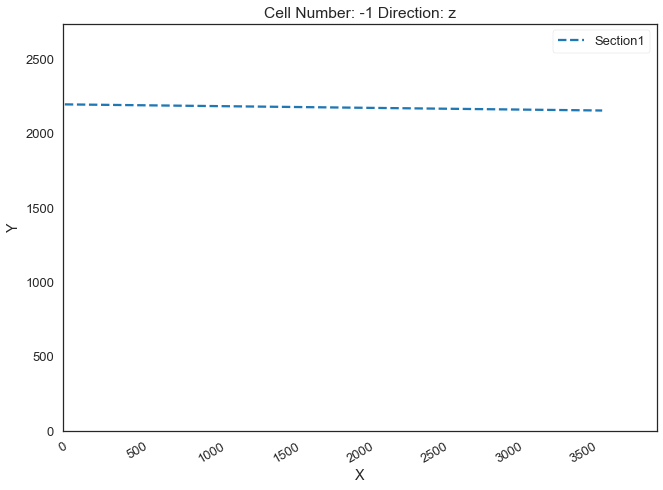
Plotting Input Data#
[41]:
gp.plot_2d(geo_model, direction='z', show_lith=False, show_boundaries=False)
plt.grid()
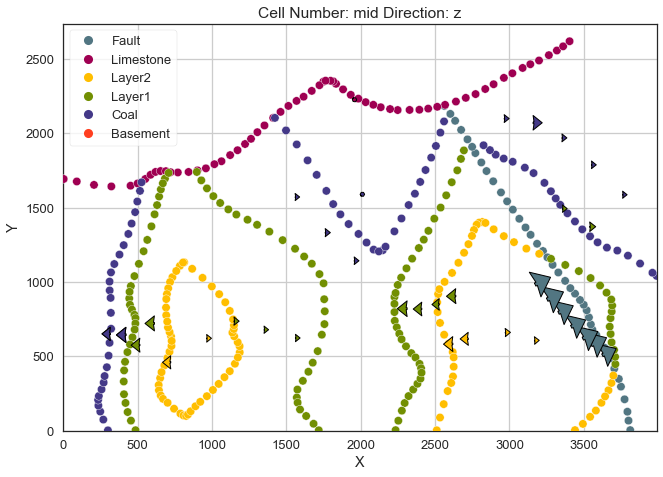
[42]:
gp.plot_3d(geo_model, image=False, plotter_type='basic', notebook=True)

[42]:
<gempy.plot.vista.GemPyToVista at 0x26662cf3490>
Setting the Interpolator#
[43]:
gp.set_interpolator(geo_model,
compile_theano=True,
theano_optimizer='fast_compile',
verbose=[],
update_kriging=False
)
Compiling theano function...
Level of Optimization: fast_compile
Device: cpu
Precision: float64
Number of faults: 1
Compilation Done!
Kriging values:
values
range 4940.22
$C_o$ 581090.38
drift equations [3, 3, 3]
[43]:
<gempy.core.interpolator.InterpolatorModel at 0x26662201100>
Computing Model#
[44]:
sol = gp.compute_model(geo_model, compute_mesh=True)
Plotting Cross Sections#
[45]:
gp.plot_2d(geo_model, section_names=['Section1'], show_topography=True, show_data=False)
[45]:
<gempy.plot.visualization_2d.Plot2D at 0x26664a9a0d0>

[46]:
gp.plot_2d(geo_model, direction=['x', 'x', 'y', 'y'], cell_number=[25, 75, 25, 75], show_topography=True, show_data=False)
[46]:
<gempy.plot.visualization_2d.Plot2D at 0x26664aa18b0>
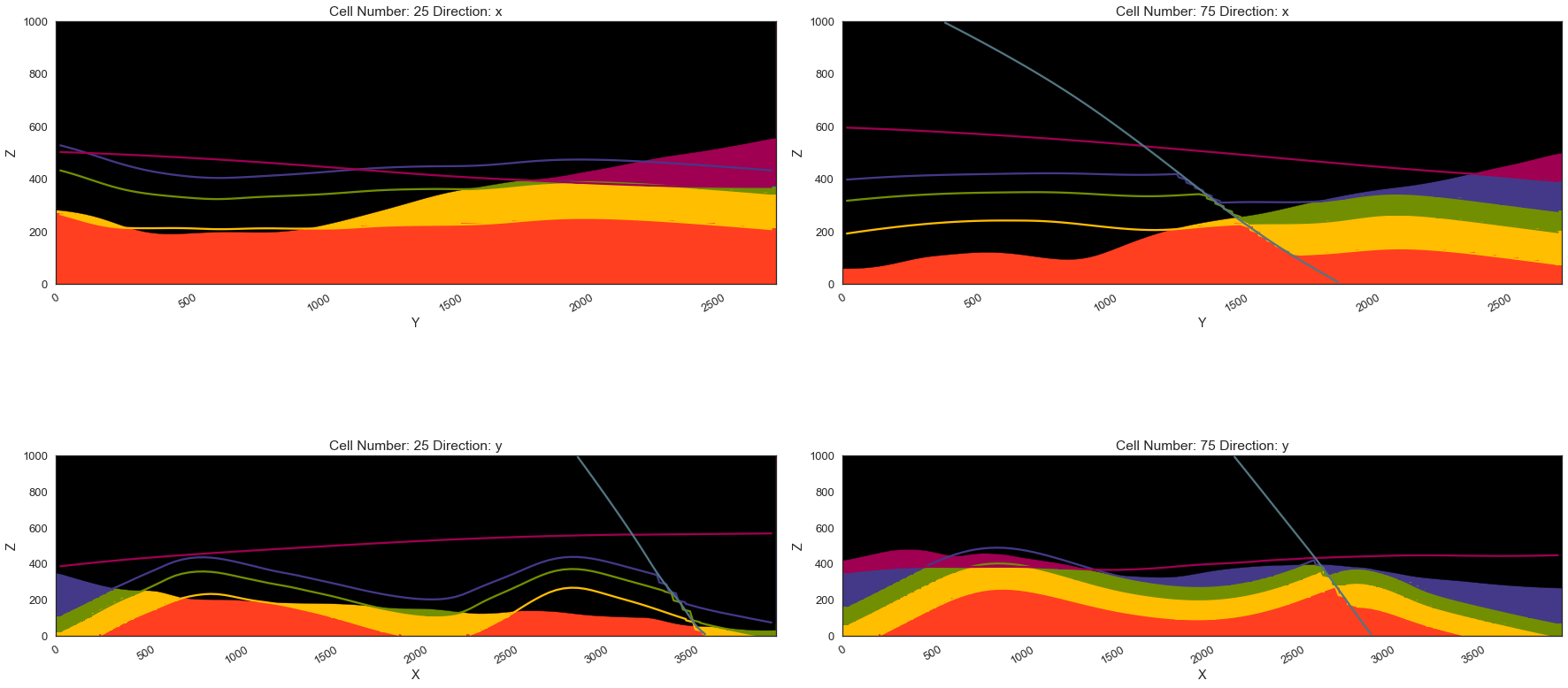
Plotting 3D Model#
[47]:
gpv = gp.plot_3d(geo_model, image=False, show_topography=True,
plotter_type='basic', notebook=True, show_lith=True)
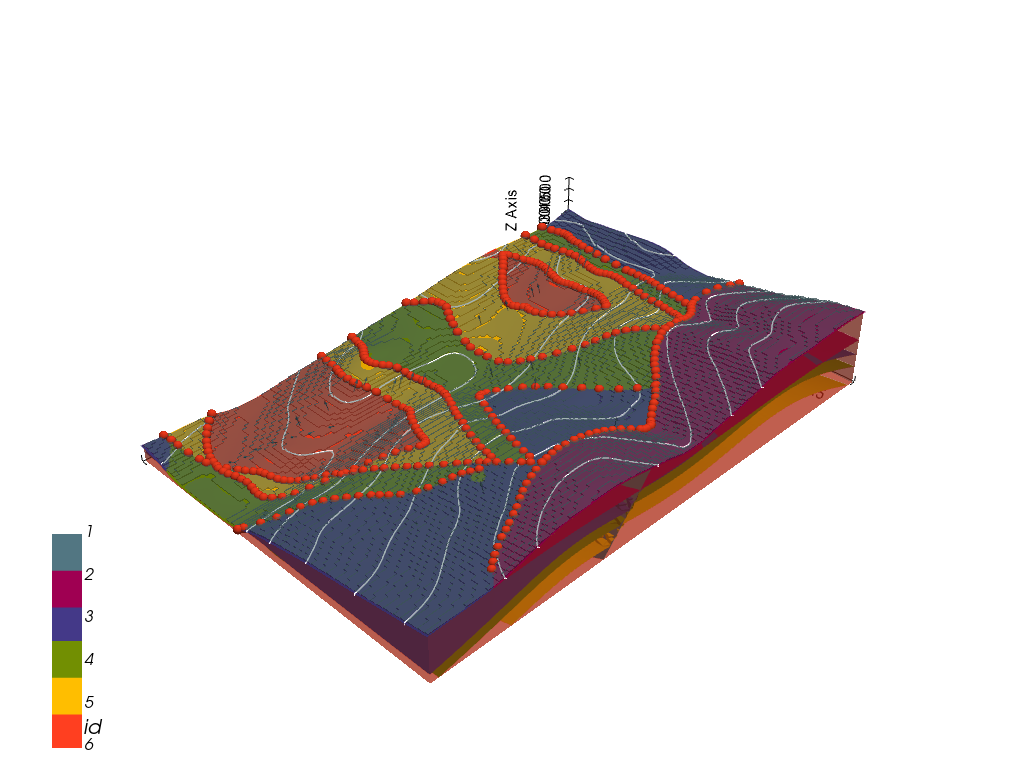
[ ]:
